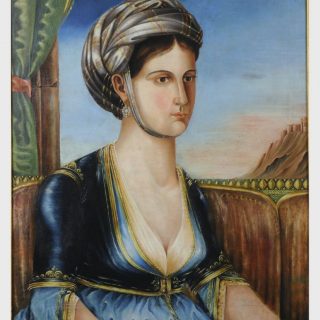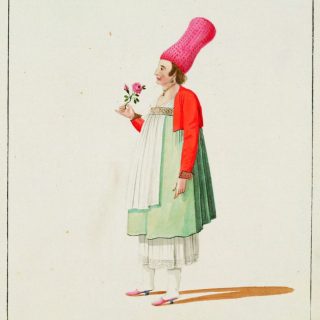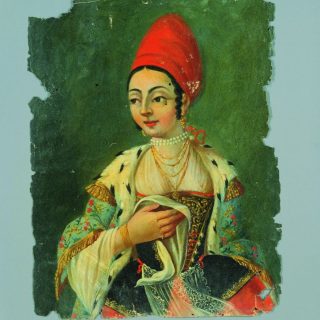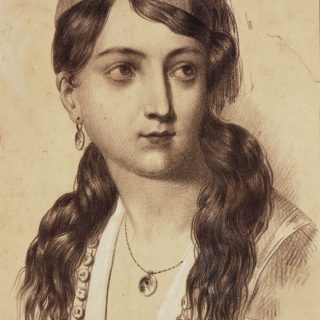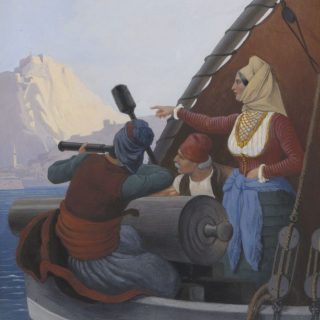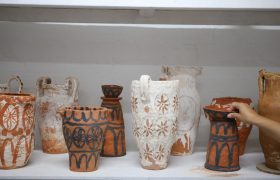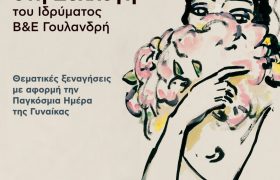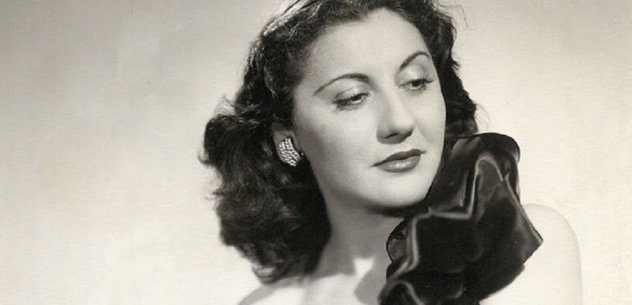Who were the Women Warriors of Greece?
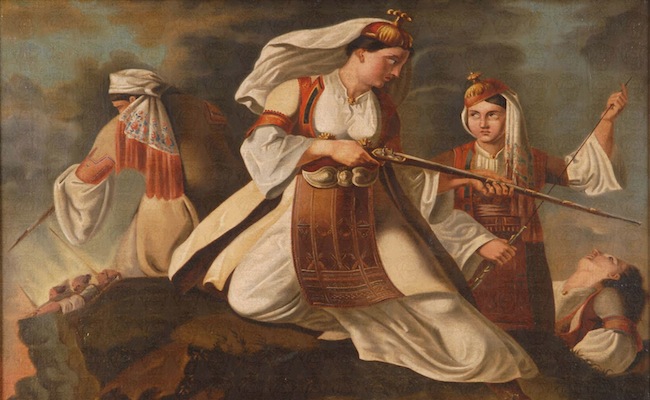
From the legendary Laskarina Bouboulina – Mother of the Greek Revolution – and the exalted “death dancers” of Zalaggo, to the executed heroines of the National Resistance against Nazi Occupation, Sakis Gekas, Associate Professor, Hellenic Heritage Foundation Chair of Modern Greek History at the University of York traces the role and changing image of the woman warrior in the canon of modern Greece in Women Warriors and National Heroes.
Modern Greece does not have an official pantheon of heroes, but it does have a rich tradition of celebrating heroines. Women Warriors and National Heroes examines historical representations of women warriors in photography, film, and monuments to understand how the image of heroic women fighters has changed during two key moments of Greece’s history. Representations of women warriors were neither monolithic nor static, but rather changed according to changing social perceptions within Greece about the role of nation, the legacy and meaning of its wars, the state of class conflict, and debates over the policing of gender boundaries and the place of women in Greek society, especially during the Greek Civil War (1946–49) and during times of political liberalization such as in the post-1974 period following the fall of the 1967–74 dictatorship.
Greece emerged as an independent state in 1830 following its War of Independence against the Ottoman Empire in the 1820s. During the Second World War, Greece experienced four years of occupation by the Italians and the Germans, as well as a resistance struggle against the occupiers. Following the German withdrawal in October 1944, a coalition government succumbed to British pressure and insisted that King George II return along with his government in exile. The coalition government failed to elicit the support of the Communist party and other resistance forces in a postwar democratic government. In protest, the Communist party abstained from the elections of March 1946 and the country plunged into a brutal Civil War that lasted for three years. The crushing defeat of the Communist Democratic Army led to the post-Civil War exclusion and persecution of everyone suspected of being a communist sympathizer. The military dictatorship of 1967–74 saw a revival of the “glory” of the 1821 revolution and a proliferation of visual representations of women warriors and heroines; after 1974 the history of heroes and heroines became of secondary importance for historians focusing on the social and economic history of the country. But in the 1980s, the Greek Parliament formally acknowledged the role of the national resistance as well as the history of the Civil War. As a result, a number of statues and busts in public places signify the commemoration of heroines of the war of independence and fighters in the resistance even in the form of the ‘unknown warrior’.
In this chapter (dedicated to Greek women warriors), I will argue that the Greek War of Independence (1821–30), the German and Italian occupation during the Second World War (1940–44), and the subsequent Civil War (1946–49) were each specific periods during which women warriors emerged, physically and allegorically, as national heroes; but the visual register and symbolic meaning of these representations of women warriorhood changed over time. In the nineteenth century, they were presented as heroic champions, usually because they fought for the nation in a similar fashion as men did. From the 1940s onward, however, the figure of the woman warrior took on new meaning, especially as Greek women fought, not just against the enemy, but also for gender equality and against patriarchal social norms, as well as national and democratic ideals. While in the nineteenth century some Greek women warriors were celebrated as heroines but also hailed as martyrs, this image changed in the 1940s when political photography depicted women as gallant fighters and used their images for propaganda purposes. The Communist movement and the press sought to establish continuities between the heroes of the Greek War of Independence and the narrative of resistance that developed after the 1940s. The history of representations of women warriors in Greece, therefore, has been contingent on the prevailing national ideology and the changing political milieu.
Women Warriors in the National Narrative of the Greek Revolution
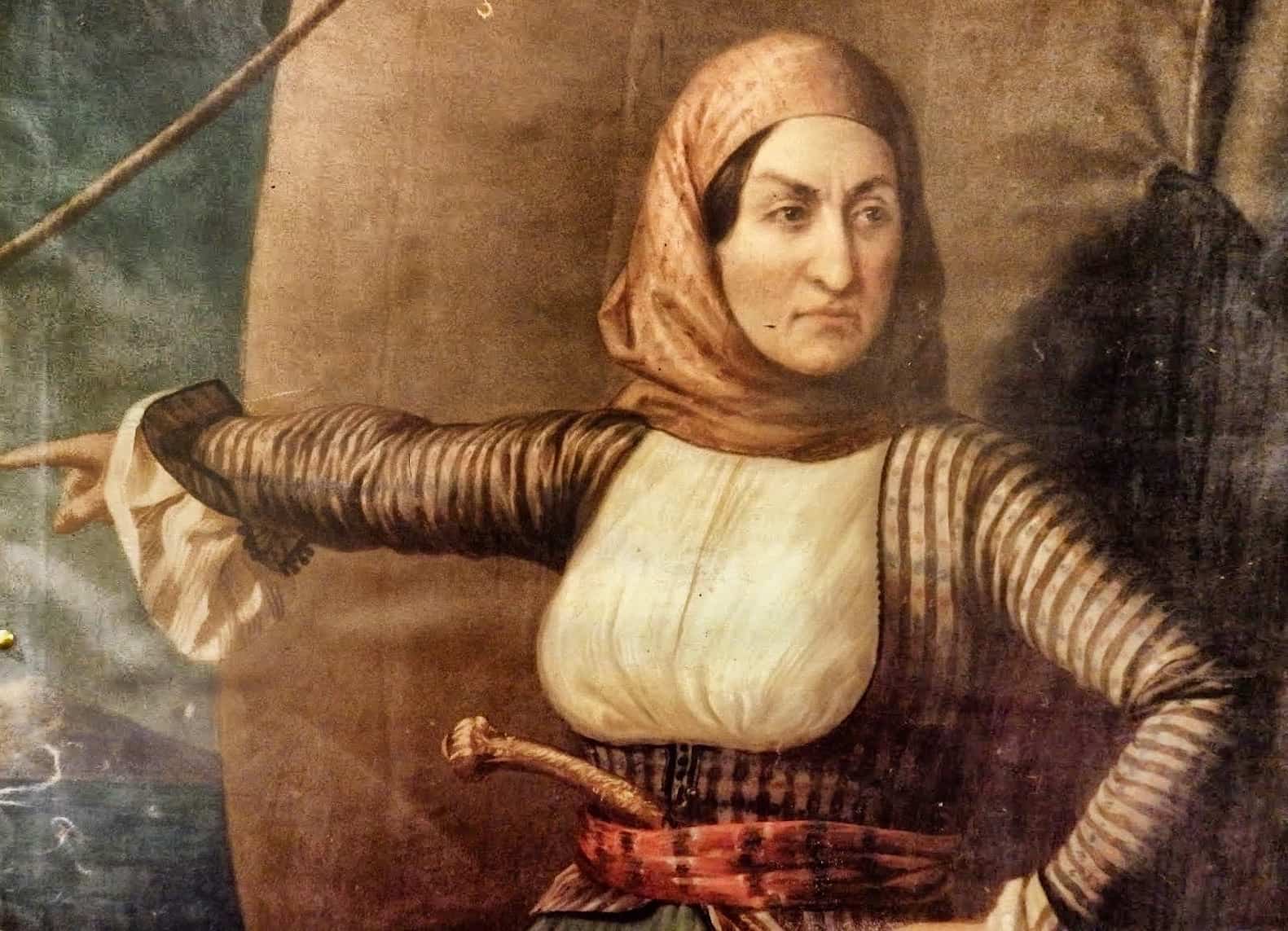
Laskarina – Bouboulina
Beginning in the 1930s, the nationalist dictatorship of Ioannis Metaxas sought to portray Greek history as a story of heroes, heroines, and sacrifice. As part of its campaign of collective memory manipulation, a prominent narrative emerged that celebrated the legendary feats of Greek women warriors during the Greek War of Independence, the nation’s foundational moment. For instance, Souliotes, men and women from Souli, a rugged, mountainous region close to today’s borders with Albania, came to occupy a central place in the Greek national narrative. Stories proliferated about how they fought fiercely for their relative autonomy against Ali Pasha, the Ottoman governor of the Southwestern Balkans whose rule extended from present-day Albania to the Peloponnese. Ali’s de facto independence incurred the wrath of Sultan Mahmud II and led to a campaign against Ali Pasha in 1820 and his decapitation, literally, in January 1822, leading ultimately to the beginning of the Greek revolution in March 1821. One story, in particular, emerged during this time and came to form a key moment in the Greek national narrative and the popular imagination: the story of the “death dance” of Zaloggo. This story, which tells of how sixty-three women sacrificed themselves by committing suicide on December 16, 1803, when they jumped off a cliff together with their children rather than surrendering and facing death or humiliation because they would have been enslaved, became legendary. It was told over and over again until it secured a place for the women of Souli in the Greek national historical canon.
The women of Souli were probably the first Greek women warriors in the modern era. This does not mean that women in other rural societies in the Greek peninsula, famous for their insubordinate defiance to centralized authority, such as Mani in southern Peloponnese, did not fight side by side with their men; it is just that Souliotisses were remembered for doing so.
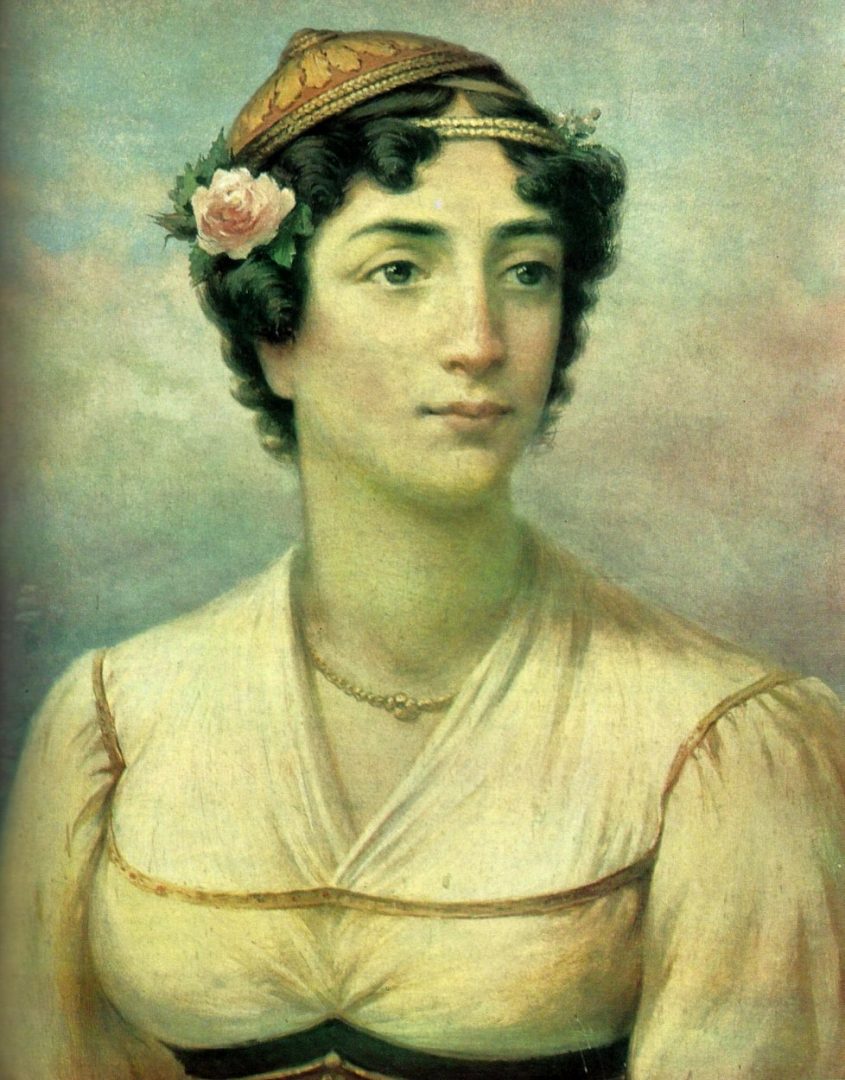
Manto Mavrogenous
As well-remembered as the Souliotisses were, two individual women of the Greek revolution, Laskarina Bouboulina (1771–1825) and Manto Mavrogenous (1796–1848), celebrated as naval commanders, have been lionized above all others in Greek national historical and popular imagination. French and British historians of the Greek War of Independence, in particular, noted the role of these two women in the 1820s war against the Ottoman Empire, often in romanticized ways. But the first book to discuss Manto Mavrogenous’s role in the war, published in Paris during the war, did not celebrate her for being a warrior per se but for her contribution to the war effort through her personal fortune. In contrast, Bouboulina, probably the most well-known woman warrior of the revolution, was a fighter. She married twice, first at seventeen to Demetrios Giannouzas and again at the age of thirty to Demetrios Bouboulis. Both husbands were from the island of Spetses, off the east coast of Peloponnese; both were captains and ship-owners; and both were killed by Algerian pirates. The tragic coincidence reveals the extent of fighting in the Mediterranean between traders and pirates, and merchant-captains from the Greek islands were renowned for switching between the two. Bouboulina’s deceased husbands left her a large fortune. Following the death of her second husband in 1820, Bouboulina constructed a large armed ship to defend her property. This was the official excuse she gave in requesting a license from the Ottoman administration, although, in reality, she was already preparing for the uprising that would come the following year. The ship, Agamemnon, was a corvette, carrying eighteen canons. Built on the eve of the Greek revolution, the ship cost 25,000 tallers and was the largest of three ships Bouboulina built and owned.
- Portrait of Bouboulina at the National Historical Museum
The War of Independence did not change gender relations and the figure of the woman warrior-at-sea was exceptional. When the revolution broke out, Bouboulina had already formed her band of Spetsiotes, who she used to call “my brave lads.” She armed and fed the crew at her own expense and at a great cost. Indeed, it is estimated that by the end of the second year of the revolution, she had nearly exhausted her fortune. Bouboulina took part in the siege of Ottoman-held forts of Nafplio and Tripoli. Following the takeover of Nafplio on November 30, 1822, Bouboulina settled there. And, a few years later, in recognition of her service to the nation, the revolutionary government granted her a house.
When Britain, France, and Russia, the protecting powers of the nascent Greek state, chose the sixteen-year-old Otto, the second son of the king of Bavaria, to become the first king of Greece in 1831, his father, King Ludwig I, sent the painter Peter Hess with him to Athens to gather materials for pictures of the war of liberation. And, of course, amongst the forty paintings Hess made depicting key figures and events of the Greek revolution up to the coronation of King Otto was a portrait of “Bouboulina.” The famous portrait has adorned school books and school classrooms in Greece for decades; it shows an image of a woman directing her ship and her soldiers in battle. French and German romantic painting certainly played a role in the popularity of some women and men warriors of the Greek revolution; this popularity increased with the circulation of stories and images during and immediately after the Revolution, primarily by non-Greek historians, who were quick to provide accounts of the war. In addition to Hess’s famous portrait, there is another nineteenth-century image of Bouboulina rendered by an anonymous painter. In this portrait, housed at the National Historical Museum in Athens, Bouboulina appears sterner, fiercer. The image served as the portrait for the 1970 100-drachmas banknote.
Bouboulina was not the only women warrior to be painted during the Greek War of Independence. Images of Manto Mavrogenous also circulated during the conflict. In 1827, Danish painter Adam Friedel included her in his series “Portraits of the Greek revolutionaries.” Friedel was one of several romantic painters who created the images of the revolutionaries that still adorn Greek school books and the National History museum. Another, Ary Scheffer, was inspired by Greek themes that extended beyond the revolution; in 1827 Scheffer painted the “sacrifice” of the Souliotisses, a fine example of the romantic liberal art produced in France in the 1820s. After the revolution, one of the early Greek painters, Miniatis, painted a much more warrior-like image of Souliotisses, arms in hand, towering over their men and a dead woman.
In the decades following independence, the Greek state education system praised the two women warriors of the revolution and commemorated the women of Souli for their sacrifice. Sotiria Aliberti’s The Heroines of the Greek Revolution, the first Greek book that explicitly wrote about heroines and women warriors, was written in the 1890s but not published until 1933. Aliberti was one of the first Greek female historians to rise to national prominence through her education and she did so in the last quarter of the nineteenth century, when some social space was opening to Greek educated women. In her stories, her heroines are entangled in events of the Greek revolution. A teacher, philanthropist, and among the first women to promote the cause of women’s emancipation in Greece, Sotiria Aliberti wrote her book while teaching at one of the most prestigious schools for Greeks in Istanbul. Her book, therefore, had an explicitly didactic purpose and was partly inspired by the partly historical, partly fictional work by Stefanos Xenos, The Heroine of the Greek Revolution. Aliberti’s narrative places women firmly at the center of major events before and during the War of Independence. The book popularized the already well-known story of the women of Souli and narrated in detail the role of Bouboulina and Manto Mavrogenous, setting the canon for later narratives.
Since the writings of Aliberti, the women of Souli, Bouboulina, and Manto have all become enshrined within national memory as prominent women warriors. The story of the women of Souli in Zaloggo acquired official status with its inclusion in the commemoration of the events of Greek Revolution on March 25, every year, taught in schools all over Greece even though it happened eighteen years before the revolution. The combination of a strong sense of local identity and kinship, an act of defiance, desperation, and bravery, contributed to the construction of patriotic but passive female identity that was propagated for decades after Greek independence. The national morale of the story is the act of maintaining honor instead of shame. In 1903 Sp. Peresiades turned the mass suicide tragic story into a popular drama that included a song and music for the performance and was labelled as a “dance,” which is how it is remembered still today. In 1959, the sacrifice of Souliotisses was depicted in Stelios Tatasopoulos’s film Zaloggo; the Castle of Freedom. This was the first time the Zaloggo story was depicted in film, a romantic nationalist picture that ends with women dancing and singing the famous song and jumping off a steep cliff. The mythologizing of the Greek revolution in film was on. And the elevation of the legend to national story was completed with the erection of a monumental site to honour the women of Souli in 1961 by sculptor N. Zogolopoulos.[16] The six female figures, abstract in form, hold hands and the monument rises up to eighteen meters as it reaches the precipice, becoming more dramatic in its visual impact from a distance as well as from the site.
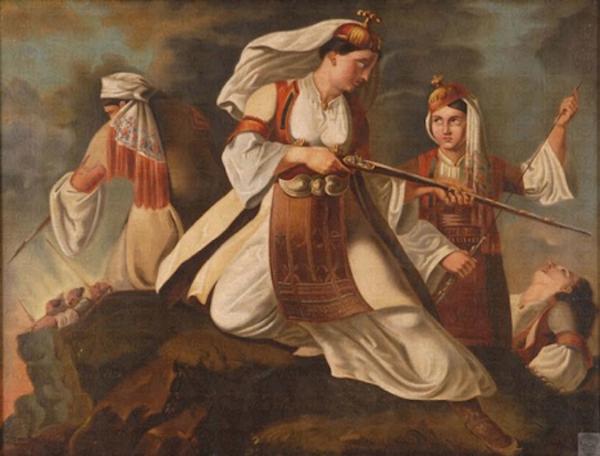
Georgios Miniatis. Souliotisses. Second half of the nineteenth century, Public Gallery, Corfu.
In 1959, the same year Zaloggo was made, the film Boubloulina was advertised as the “legendary movie,” the “glory of Greek courage.” Beyond film, both Bouboulina and Manto are revered in public spaces; the statue of Bouboulina in the Spetses main square confirms her central role in the local and national history and Bouboulina’s image has adorned postal stamps and an old fifty drachmas banknote. Manto Mavrogenous has also received by the state the fame and recognition she deserved; a central square in Mykonos was named after her and a statue was erected. There are many streets in Greece bearing her name and she is depicted in commemorative coins, school textbooks, and portraits in classrooms. In 1971, director Kostas Karagiannis made a film, Manto Mavrogenous, depicting Manto as a courageous woman who played a pivotal role in the Greek revolution in a world of strong and hot-headed men.
Women Warriors in the 1940s. Women of the Resistance and the Civil War
In times of conventional wars, such as the Balkan Wars of 1912–13, the First World War, and the subsequent Greco-Turkish War (1919–22), there was little room for heroic deeds by women, who were relegated to supporting roles at best. However, when state authority—and established gender norms with it—collapsed under foreign occupation and was subsequently challenged by an armed uprising, women resurfaced as combatants and heroes. American author Henry Miller captured this phenomenon in his classic 1941 travelogue of Greece, The Colossus of Maroussi, when he wrote that:
Everywhere you go in Greece the atmosphere is pregnant with heroic deeds. I am speaking of modern Greece, not ancient Greece. And the women, when you look into the history of this little country, were just as heroic as the men. In fact, I have even greater respect for the Greek woman than for the Greek man. No wonder Durrell wanted to fight with the Greeks. Who wouldn’t prefer to fight beside a Bouboulina, for example, than with a gang of sickly, effeminate recruits, from Oxford or Cambridge?
With Greece about to be enveloped by the storm of invasion, occupation, resistance, and Civil War, Miller was invoking the most famous heroine of the Greek revolution, one who the Greeks themselves still remembered and who they would use in new ways in this new context at the same time as new women warriors would emerge from almost a decade of conflict.
On October 28, 1940, Italy invaded Greece; the Greek army mobilized and achieved the first victory against an Axis power in November 1940, when it stopped the Italians and forced Hitler to draw up plans to invade Yugoslavia and Greece to secure his southern-European—Balkan flank. During the war in the mountains of Pindos between Greece and Albania, women played a new—and decisive—supportive role, for which they have been celebrated as “the women of Pindos.” These women assisted men in fighting by climbing the mountains to bring ammunition, resources, tending for the wounded and carrying essentials on animals, or even on their own backs. Their role was crucial for morale, demonstrating in practice that the whole nation was behind the defensive effort, with Greek men and women all fighting defending their country against Italian aggression. The story and symbolism became an official monument, erected in Thessaloniki in 1990 and in two additional areas near the border with Albania, one in Pentalofos and the second one in Zagori in 1993.
In April 1941, the German army invaded Greece and, together with the Italian and Bulgarian armies, occupied the country until October 1944. The brutal occupation period saw the plundering of Greek resources and the starvation of up to a quarter of a million people during the winter of 1941–42. This disaster led to the emergence of one of the fiercest resistance movements in Nazi-occupied Europe as well as one of the highest death tolls in Europe in reprisals by the occupying forces. The Resistance, as it widely known, saw many heroines, but there were also large numbers of “anonymous” women who took part. However, the memory of the 1940s and the resistance period of 1941–44 is entangled with the much more contested history of the Civil War that followed in 1946–49, which meant that it was not officially acknowledged by the state and made part of the official narrative only in the 1980s. As a result, the story of three of the women who were executed by the occupying forces and their Greek collaborators—Lela Karagianni, Iro Konstantopoulou, Electra Kostopoulou—became known belatedly. There are now many accounts, oral histories, and other works showing that one of the most radical elements in the Resistance movement was the mobilization and participation of women. The shift is also partly due to the rise of public history and historical awareness of the period of the 1940s beyond university departments and academic conferences, where it has enjoyed popularity for almost twenty years.
The stories of these three heroines reveal the different walks of life they came from but also the representations of women as warriors and heroines in monuments and popular images such as film. Lela Karagianni is probably the best-known heroine of the National Resistance against the Nazi Occupation. When the German army invaded Greece in April 1941, thousands of British soldiers did not make the evacuation from the mainland to Crete and then to Egypt.
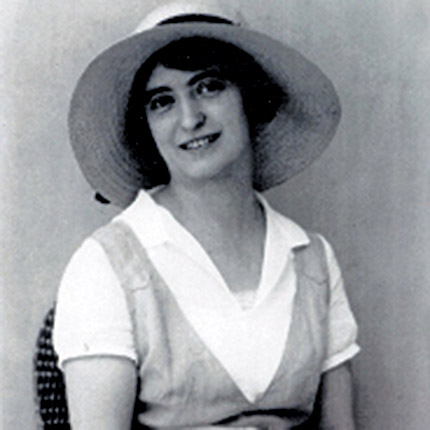
Lela Karagianni
Lela Karagianni quickly found other like-minded patriots and together they helped the soldiers who had been left behind connect with the Resistance and escape from Athens, first to Crete and then to Egypt. Karagianni used her husband’s drugstore and perfume store and their house as a hideout for British soldiers seeking to escape, as well as helping numerous starving children in occupied Athens. Karagianni named her resistance organization Bouboulina, after the famous woman-captain. Curiously, this independence hero was also her distant ancestor, although is unclear whether the extraordinary coincidence played a role at all in Karagianni’s determination to form and lead a resistance organization. The “Boubloulina” group sabotaged German installations, provided the Allied Middle East Command in Cairo with intelligence, and helped Resistance fighters in any way they could. Karagianni’s children also helped, risking their lives and those of their siblings. When arrests started in June 1944 Karagianni was warned that she should go into hiding, but refused and in September 1944, was arrested together with five of her children. She was interrogated and tortured to make her turn in the other members of the organization; she refused to do and on September 8, 1944, only a few weeks before the German army evacuated Athens, on October 12, she was executed, as part of the last major execution of Greek patriots.
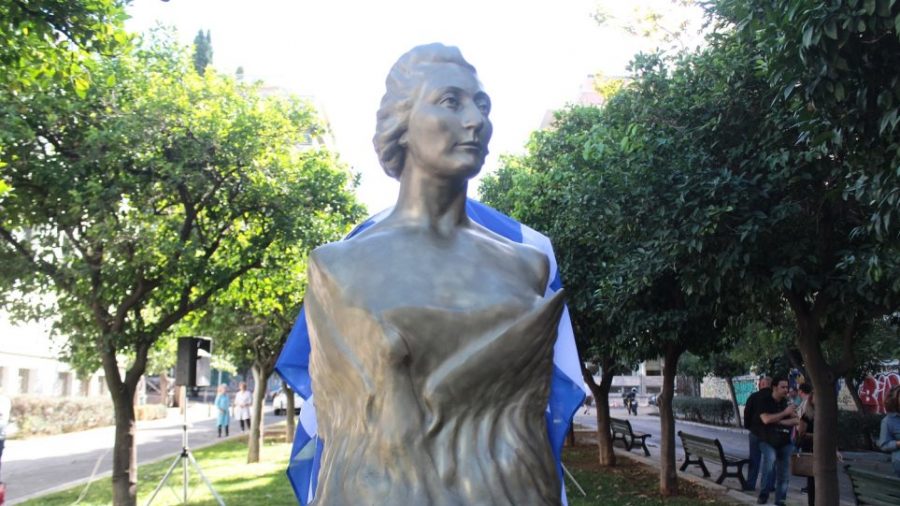
Lela Karagianni’s bust on Tositsas street, near Omonoia
During her final moments, she is supposed to have sung the national hymn and danced the “Zaloggo dance,” putting hope into the fearful hearts of her fellow patriots. This is probably more legend than reality but the way the sacrifice of women in the early-nineteenth century was connected in the popular imagination with the resistance woman fighter of the 1940s is striking. Karagianni is not nearly as famous as Bouboulina or Manto Mavrogenous because she fought in a different war and because the National Resistance was acknowledged only in 1982; however, she has received state recognition and a street bears her name and in 1963 a small bust was erected near Omonoia Square and Patision avenue, where she lived and run her organization, testament to the acknowledgement of her sacrifice. The legacy of Lela Karagianni and the continuity with the heroines of the Greek revolution is evident in the title of one of her most recent biographies, The Bouboulina of the Occupation.
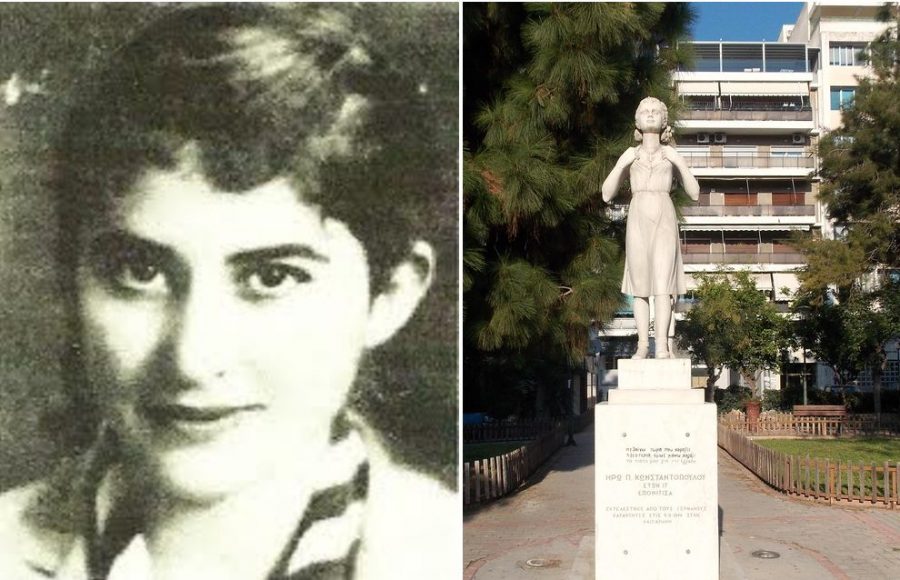
Iro Konstantopoulou who was shot dead at just 17.
Iro Konstantopoulou joined the resistance youth organization EPON (United Panhellenic Organization of Youth) in 1943 when she was a high school student. In July 1944 she was arrested and tortured. While in jail she became close to Lela Karagianni, who encouraged her through the difficult days. Together with other patriots, the seventeen-year-old Konstantopoulou was executed on September 5, 1944, in Kaisariani, Athens. The report of her death mentioned that, to set an example, she received seventeen bullets, one for each year of her life. A movie about her, Seventeen Bullets for an Angel was made in 1981; to emphasize her youth, it depicted her wearing her school uniform. Interestingly, she was awarded the “title” of heroine in 1977, before the political change of 1981, when the Academy of Athens, a traditionally conservative institution, honoured her memory for her ultimate sacrifice, acknowledging indirectly the contribution of EPON to the resistance. The official state recognition took place the next year, when the parliament passed the National Resistance Act.
Women in the Resistance came from all walks of life, from the cities to the countryside, from the educated to the illiterate. Some were members of the Communist Party before the War. One of these was Electra Apostolou, who had joined the Communist Party Youth in 1926 and quickly became a leading figure, representing the Greek Communist Party at the Antifascist and Antiwar World Conference of Women in Paris in 1935 and the World Congress of the Communist International Youth in Moscow in 1936. She left home when she was seventeen, abandoning a fairly comfortable bourgeois life. She was imprisoned during the Metaxas dictatorship in 1936 and in 1939, she gave birth to her baby girl in prison. They were both sent to the tiny, isolated island of Anafi (it is still two hours by boat from Santorini), from where she escaped in 1942 to join the Resistance. In 1944, she was arrested, tortured, and executed by the Nazi security forces and Greek collaborators in Athens. Εlectra Apostolou was a pioneer in the sense that she promoted the aim of establishing equality of women, not only in society and in law but in each family.
The road that Electra Apostolou paved for Greek women would be soon followed by several other women in the Resistance through their participation in the ELAS (Greek People’s Liberation Army) and the EPON during the Occupation. The most important representations of these women in arms came political photography, and especially the work of Spyros Meletzis. His work on women fighters of the resistance became known following the photo exhibition at the EAM (National Liberation Front) headquarters in Athens in October 1944, soon after the liberation of the city. One of the women that Meletzis’s lens immortalized was Eleni (Titika) Panagiotidou, who he selected as “the face of the Resistance.” One of Meletzis’s photographs adorned the first stamps that commemorated the Resistance in 1982. Panagiotidou’s story became widely known when she died in October 2018.
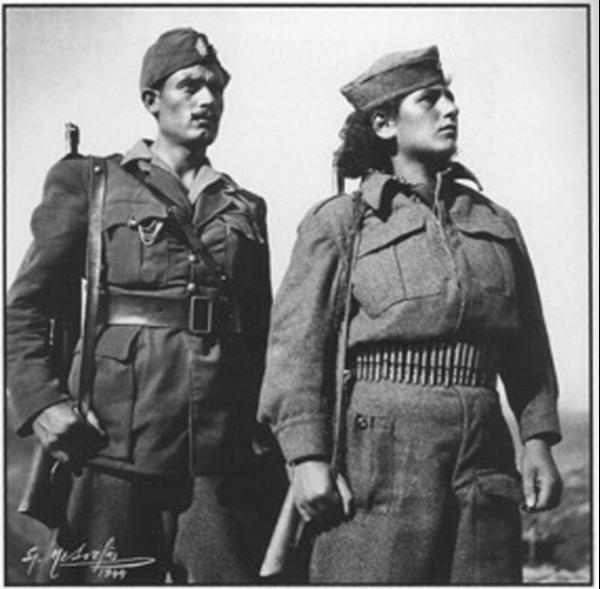
Eleni Panagiotidou, photographed by Spyros Meletzis
The carefully staged and posed photograph shows Panagiotidou, ahead of a man; firm, they are both well-dressed, even though she seems to be wearing a slightly lower-quality uniform. The couple are young—probably in their twenties—and the photograph is taken from below, to increase the impact of the image.
Meletzis was not alone in creating heroic representations of female Resistance fighters. Around the same time, in 1944 the images of the Youth Resistance organization EPON represented women equally, next to young men, waving flags, climbing stairs toward the sun, inspiring women during the grim days of the Occupation. The resistance was becoming a great opportunity for emancipation for Greek women.
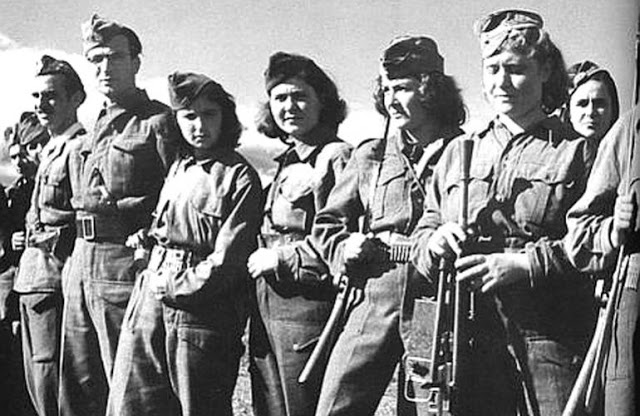 The last case of group women warriors to be discussed were the women fighters of the Democratic Army (DA), the Communist Party Army that fought against the national government in the Civil War that began in 1946, after the “white terror” in 1945 and the elections of April 1946 from which the Communist Party abstained. Most DA women fighters were teenagers or young women when the ELAS army, the resistance army during the Occupation, allowed women to participate in novel ways. Photographic representations of anonymous women fighters show how images of women fighters were used by newspapers and political organizations to deliver their message. Since the early-twentieth-century, photographs of armed men had been prominent and circulated in postcards, newspapers, and other forms of popular literature. They were often accompanied by captions extolling their courage, honour, self-sacrifice, loyalty, solidarity, and bravery. But until the 1940s, photographic representations of women were limited. When photographed at all, they were usually depicted as martyrs or victims of war, not heroic fighters. The Civil War changed that.
The last case of group women warriors to be discussed were the women fighters of the Democratic Army (DA), the Communist Party Army that fought against the national government in the Civil War that began in 1946, after the “white terror” in 1945 and the elections of April 1946 from which the Communist Party abstained. Most DA women fighters were teenagers or young women when the ELAS army, the resistance army during the Occupation, allowed women to participate in novel ways. Photographic representations of anonymous women fighters show how images of women fighters were used by newspapers and political organizations to deliver their message. Since the early-twentieth-century, photographs of armed men had been prominent and circulated in postcards, newspapers, and other forms of popular literature. They were often accompanied by captions extolling their courage, honour, self-sacrifice, loyalty, solidarity, and bravery. But until the 1940s, photographic representations of women were limited. When photographed at all, they were usually depicted as martyrs or victims of war, not heroic fighters. The Civil War changed that.
Photographs of women during the conflict were often based on existing stereotypical postures and ideas about courage, honour, sacrifice. Such images and references are abundant in accounts of the Greek revolution and in the few images that foreign painters produced. The women who fought in the Civil War, however, were not presented as descendants of the Souliotisses and Bouboulina. From an aesthetic point of view the legacy of Meletzis is paramount; shooting from below, depicting women with their heads looking up became the standard image of the struggle of women in the Left. Reactions to those photos ranged from enthusiasm and pride to serious concerns to moral panic. The Resistance opened a space for women to challenge existing norms and traditional female roles in family and society. In the 1940s and especially during the Civil War, women were present everywhere: enlisting, fighting, nursing, in prison, being executed. Women were not merely “on their men’s side” as the traditional narratives from the Greek Revolution suggested, but were fighting equally.
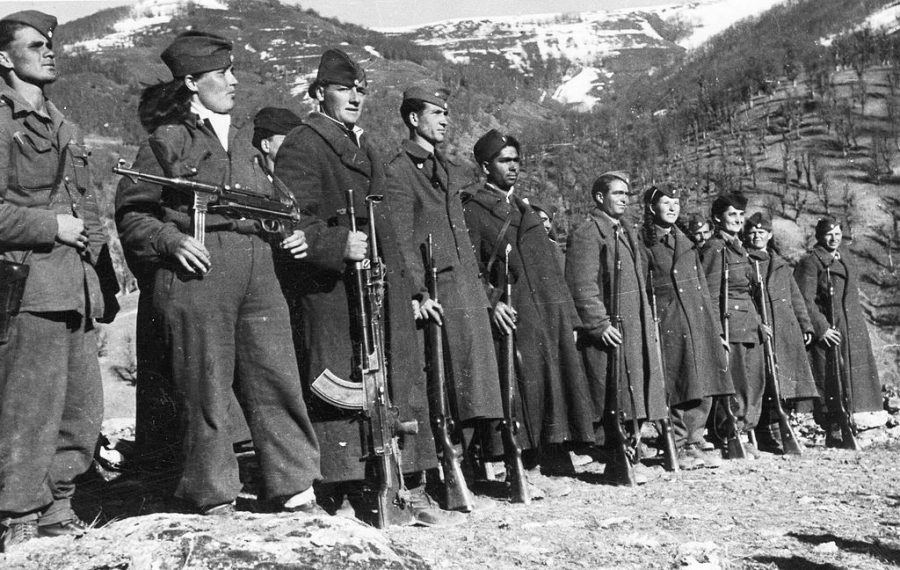 The two sides in the Civil War presented women very differently. On the government side, they were not shown fighting on behalf of the national army, or even assisting them. The government-friendly press published photographs of women that projected family values and virtues, such as raising children, participating in events supporting the army fighting the “insurgents,” all neatly dressed, smiling, and full of joy from performing their—gendered—national duty. In contrast, women in the mountains of “free Greece,” as it was called, earned their right to political participation by enlisting and becoming party members. This was a space from which, in normal circumstances, they were excluded, both constitutionally and socially.
The two sides in the Civil War presented women very differently. On the government side, they were not shown fighting on behalf of the national army, or even assisting them. The government-friendly press published photographs of women that projected family values and virtues, such as raising children, participating in events supporting the army fighting the “insurgents,” all neatly dressed, smiling, and full of joy from performing their—gendered—national duty. In contrast, women in the mountains of “free Greece,” as it was called, earned their right to political participation by enlisting and becoming party members. This was a space from which, in normal circumstances, they were excluded, both constitutionally and socially.
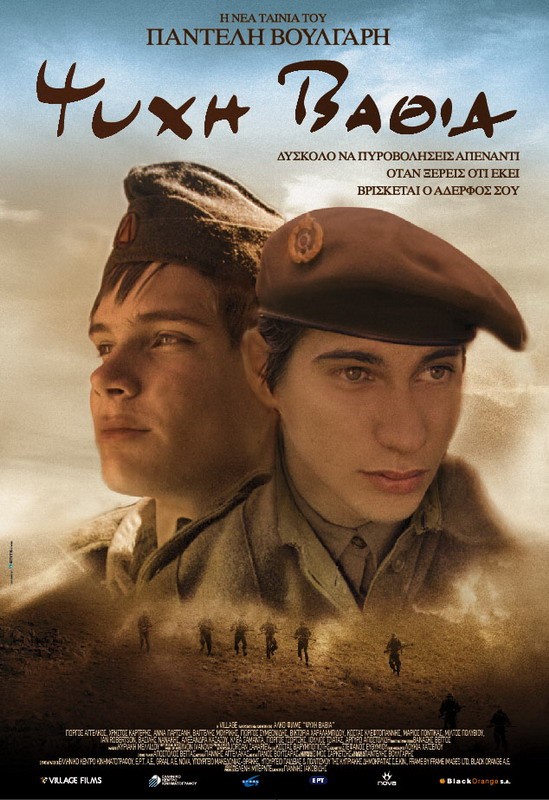
One of the first representations of women in arms after the liberation was in a left-wing newspaper, Eleftheri Ellada [Free Greece], in 1946, before the outbreak of the Civil War. The composition consists of two images that illustrate the transition. The first photograph shows a woman ironing wearing an apron, looking down, occupied in her chores and almost submissive in her traditional role; the second shows women fighting but relaxed, almost casual in their military uniform and bearing arms, two of the three shooting with a machine gun. This is an image that was reproduced in the 2009 film by Pantelis Voulgaris, Psychi Vathia [Deep Soul], one of the most emblematic, if stereotypical, depictions of the Civil War in film, that won both acclaim and received severe criticism for appearing to take equal sides in the conflict.
Women organized themselves during the short post-liberation peaceful period. In 1946, the Panhellenic Federation of Women was founded by thirty-five women’s groups representing tens of thousands of women. Many women entered the Civil War having organizational experience; some had military experience as well. It is estimated that around 30 per cent or 8,000 fighters of the Democratic Army in the Civil War were women, including 688 officers. When British photographer Nancy Crawshaw visited Greece for five months in 1947 between February and July 1947 she went to the stronghold of the partisans in Kastanofito, near the city of Kastoria in North West Greece, where she photographed young women fighters of the Democratic Army. Crawshaw noted that: “the partisan movement attracted many women who believed that they would gain equal rights with men, and who suddenly deviated from the traditional labour they did for centuries, as farmers, confusing in their mind the sound of the machine gun under men’s power with true emancipation.” Fifty-five DA women were decorated for bravery and 244 for heroic action. Based on autobiographical accounts as well as on reports from other participants, there is no doubt women fighting in the Civil War instilled courage in their comrades in the mountains and shocked and outraged their opponents in the national army. Women were given equal roles in the hierarchy and fought with equal determination for their cause.
Needless to say, many were killed, injured, imprisoned, summarily tried and executed, or exiled and spent decades as political refugees in Communist countries. One of them, Eirini Gini, Slavophone from the village of Xanthogia (Rousilovo) in North Greece, was a teacher before the war and is known for being the first woman that was be executed because of her participation in ELAS, the Resistance army, and for being a member of the Communist Party. Because of the tainted reputation of Slavophone Greeks in the region, who followed the Communist Party line on autonomy for the region of Macedonia, Gini has been elevated to the status of a war hero in the Republic of North Macedonia, where there is a statue of her in Bitola. Thus, a Greek warrior who was “expelled” from the national narrative in the post-Civil War period because of her beliefs and her pronounced ethnic identity was “adopted” by a neighbouring state for its own nationalist narrative. Another woman, Olga Mastora Psarogianni, who I interviewed in 1999, fought with the communists in the Resistance and the Civil War, was wounded and found herself in 1948 in Yugoslavia. Olga lost touch with her husband but they reunited in Hungary in 1951; she, however, refused to give up and although she had a two-year-old daughter, she went to Greece for three years to reorganize the clandestine Communist network in the country; if caught, she would have been executed for treason, since the Communist Party was outlawed in 1947. Her story represents a very different kind of fighter, as it transpired in her autobiography after she returned to Greece from Hungary in the late 1980s. Thousands of other women fought in the Civil War and were immortalized in the writings of the Communist Party and many who survived lived in exile for decades in communist East European countries and the Soviet Union before being allowed to repatriate in Greece.
The Democratic Army of the Communist Party managed to print a series of booklets specifically about women and their role in the struggle. Some of those writings propagate the image of women fighter—sometimes called heroine—repeatedly. The publications aimed at condemning the atrocities against women and even teenagers in the villages of Kastoria, a region with many Slavophones who supported the Democratic Army. In 1948 Roula Koukoulou, wife of Communist Party General Secretary Nikos Zachariadis, presented her account of the women fighting on several fronts against the enemy in her speech at the first meeting of the Panhellenic Democratic Union of Women. Despite such declarations, however, it is more likely that the morale of women as well as of all fighters in the Democratic Army gradually deteriorated from 1948 onward, since despair and the appalling living conditions in the mountains took their toll. As the war dragged on, the publications of the Communist Party continued; in March 1949 on the occasion of March 8th, the International Women’s Day, the Democratic Army published the booklet “Women Fighters of Freedom,” which presented the stories of several women fighters, their struggle and achievements and their determination, against all odds, to defeat the enemy and achieve class victory and female emancipation.
In 1948, as the Communist Party insurgent army was losing ground, the photographs published in government-friendly newspapers such as Empros aimed to shock the public and humiliate the captives. The image of a fourteen-year-old girl looking understandably angry was used to “name and shame” her, as her name and the village of origin were published; “such a disgrace of a young girl is unimaginable,” the caption of the photograph read. The article “revealed” other information about the appearance and characteristics of the women partisan fighters. According to the reporter, partisan women had lost all their femininity and their appearance was “disgusting.” Another newspaper, Ethnos, published a “report” on the “problem of partisan woman.” The newspaper outlined “the problem” focusing—literally—on the female faces while the article fantasized about the alleged sexual promiscuity, the sensuality, and the sexual life of the beautiful women who, it claimed, the partisans had abducted from the virgin Greek countryside and turned them into concubines. The photographs aimed to stress the “point” about the abilities of partisan women to seduce as well as die for their “communist cause.”
Conclusion
In the period after the 1821 revolution that led to the creation of an independent Greek state, the national narrative elevated few women to the status of national heroines even though they gave their property rather than their lives and did not always take part in the fighting. Bouboulina, the most famous of all, epitomized the woman warrior of the revolution. Other, anonymous, women were portrayed as having chosen to die instead of surrendering to “the Turks” because their story fitted the national imagination. Almost a century and a half later, the Zaloggo legend and the song that accompanied the play acquired a new meaning when it was declared a piece commemorating the national drama.
In the 1940s, resistance to the German-Italian occupation led to the movement of thousands of women who saw their aspirations for emancipation realized through the ranks of the Resistance organizations. The legacy of the heroic women of the War of Independence resonated in this new context. Lela Karagianni named the resistance organization she formed “Boubloulina” and women of the Resistance were referred to as the “women of Zaloggo,” and the “present-day Souliotisses.” Women imprisoned for treason and executed during the Civil War went to their deaths singing the “dance of Zaloggo” song. In the 1940s, however, 120 years on from the Greek Revolution, women were not dancing their way to death jumping off a cliff, but were fighting in uniform with a rifle (or even a machine gun) in their hands, a testament to the great strides in women’s emancipation that was achieved during the 1940s. Images of those women warriors circulated widely thanks to political photography that popularized and glorified the women of the Resistance. In the 1950s, onward popular images in film and monuments of women warriors served the national narrative of the Resistance and representations of women were brought up to date with the place of women in Greek society.
Excerpts from ‘From the Nation to Emancipation: Greek Women Warriors from the Revolution (1820s) to the Civil War (1940s)’ by Sakis Gekas, Women Warriors and National Heroes, Bloomsbury Collections, 2020

